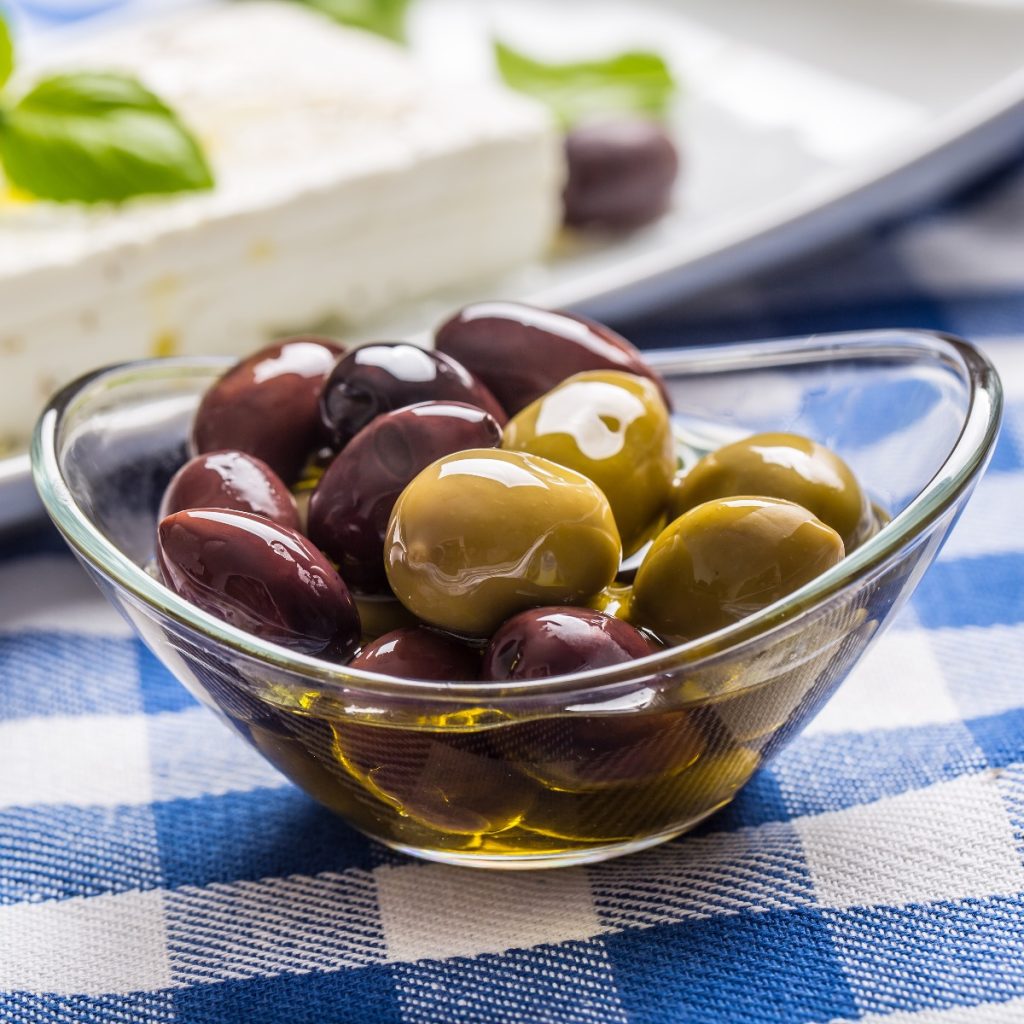All About Olives
I love olives and the products prepared from them. I can’t imagine not having olive oil to cook and drizzle on foods. And how can you have a charcuterie board with no olives? And what about pizza?
What Are Olives?
Olives are small, oval-shaped fruits that grow on olive trees and are native to the Mediterranean region. The tree is an important species for human civilization, as it has been cultivated for thousands of years for its fruit, oil, and wood.
Olives come in different varieties, each with its distinct flavor and texture. Some of the most popular types of olives include Kalamata, Picholine, Manzanilla, and Niçoise. Green olives are usually picked before they are fully ripe, while black olives are picked when they are fully ripe.
Olives are often used in cooking and for their oil, which is extracted from the fruit. Olive oil is one of the healthiest oils in the world and is widely used in Mediterranean cuisine. It is rich in monounsaturated fats, which can help to reduce the risk of heart disease and stroke. Olive oil is also high in antioxidants, which help to protect the body against damage from free radicals.
Medicinal Purposes
In addition to their culinary uses, olives have been used for medicinal purposes for thousands of years. The ancient Greeks and Romans believed that olives had many health benefits, including improving digestion, reducing inflammation, and relieving pain. Today, scientists have confirmed many of these ancient beliefs, and research has shown that olives contain several essential nutrients and phytochemicals that can positively impact human health.
For example, olives contain a high level of oleic acid, a monounsaturated fat that has been shown to help reduce the risk of heart disease. They also contain polyphenols, antioxidants that help protect the body against damage from free radicals. In addition, olives contain several vitamins and minerals, including vitamin E, vitamin K, and iron.
Another important benefit of olives is their potential to improve brain health. Olives contain a type of polyphenol called hydroxytyrosol, which has been shown to have neuroprotective effects. This means it can help protect the brain against damage and improve cognitive function. Some studies have also suggested that olives can help to reduce the risk of developing certain neurodegenerative diseases, such as Alzheimer’s and Parkinson’s.
Olives can also be a beneficial addition to a weight management diet. Despite being high in fat, olives are low in calories, and the monounsaturated fats they contain can help to reduce the risk of obesity. Additionally, research has shown that consuming a diet rich in monounsaturated fats can help reduce belly fat, a risk factor for heart disease and other health problems.
Cultural Traditions
In addition to the health benefits of olives, they are also an essential part of many cultural and religious traditions. For example, olives are often used in the Mediterranean as a symbol of peace and good luck. They are also crucial to many religious ceremonies and rituals, including the Jewish Passover.
Growing olives is an ancient tradition that has been passed down through generations. Olive trees are hardy and can live for hundreds of years, making them an important crop for many communities. In addition, the trees are grown using sustainable practices, such as natural methods to control pests and diseases.
Olives are usually harvested by hand, which is done carefully to avoid damaging the fruit or the trees. The olives are then sorted and processed to be eaten fresh or turned into olive oil. The production of olive oil involves extracting the oil from the fruit, which can be done using traditional methods or using modern machinery.

A Little History
The olive tree (Olea europaea) is native to the Mediterranean region and has been cultivated for thousands of years. Its origins are uncertain, but it is believed to have originated in the eastern Mediterranean or the area around the Caspian Sea.
Olives were an important food source for ancient civilizations, including the Greeks and the Romans, who also used olive oil for cooking, lighting, and skincare. The olive tree was also considered sacred in ancient Greece and was associated with Athena, the goddess of wisdom.
Olives spread throughout the Mediterranean through trade and commerce and became an integral part of the diet and culture of the region. Today, olives and olive oil are still essential to Mediterranean cuisine and are enjoyed worldwide.
In addition to its culinary uses, the olive tree has also played a significant role in the history and culture of the Mediterranean region, with olive groves being an important symbol of peace and prosperity.
How Many Olive Varieties Are There?
There are hundreds of different varieties grown in countries throughout the world. Some of the most well-known varieties include the Spanish Manzanilla, the Greek Kalamata, the Italian Castelvetrano, the French Nicoise, and the Indian Alfonso, among many others.
The exact number of olive varieties is difficult to determine as new cultivars are constantly being developed. Existing varieties can vary significantly depending on the growing conditions and local practices. Additionally, some varieties may be known by different names in different regions, making it challenging to get an accurate count.
10 Types of Olives
- Kalamata: A Greek olive that is large, firm, and meaty with a slightly tart flavor.
- Manzanilla: A Spanish olive that is medium-sized, mild in flavor, and commonly used in martinis.
- Castelvetrano: An Italian olive that is large, round, and bright green in color with a mild, nutty flavor.
- Nicoise: A French olive that is small and black, with a firm texture and a slightly salty flavor.
- Gaeta: An Italian olive that is small and dark purple with a slightly sweet flavor.
- Picholine: A French olive that is long, green, and has a tangy, slightly bitter flavor.
- Cerignola: An Italian olive that is large and round with a mild, nutty flavor.
- Amfissas: A Greek olive that is small and black, with a firm texture and a slightly salty flavor.
- Ligurian: An Italian olive that is large and oval-shaped, with a meaty texture and a mild flavor.
- Alfonso: An Indian olive that is large and oval-shaped with a sweet, nutty flavor.
Why Are Some Olives Green and Some Black?
The color of an olive is primarily determined by its ripeness. Green olives are harvested before they are fully ripe, while black olives are allowed to mature on the tree. The color difference is due to changes in the levels of chlorophyll and other pigments in the fruit as it ripens.
In addition to ripeness, the type of olive can also play a role in its final color. Some olive varieties naturally produce green or black fruit, and some varieties may have a mix of green and black fruit on the same tree. Other factors, such as growing conditions, can also influence the color of an olive.
The flavor of green and black olives can also be different, with green olives tending to have a more bitter, astringent taste, while black olives are generally milder and sweeter. The curing process can also affect the flavor, as different methods can produce olives with distinct flavor profiles.

What Do Olives Taste Like?
Olives have a distinctive, salty, briny flavor that is often described as tangy or bitter. However, the exact taste of an olive can vary depending on several factors, including the type of olive, its ripeness, and the processing method used.
Green olives tend to have a more bitter, astringent taste, while black olives are generally milder and sweeter. In addition, some olives may have a nutty or fruity flavor, while others may have a more intense, salty taste. The curing process can also affect the flavor of olives, as different methods can produce olives with distinct flavor profiles.
Often soaked in vinegar, oil, herbs, or spices, marinated olives may have a different flavor profile than unpreserved olives. Stuffed olives can have a variety of flavors, depending on the filling used, ranging from mild to strong.
Are Olives a Fruit or a Vegetable?
Olives are considered a fruit because they contain seeds and are produced from the ovary of a flowering plant. They are classified as a stone fruit, along with other fruits such as cherries, plums, and apricots.
The fruit of the olive tree is used for its oil, one of the most commonly used cooking oils in the world, and its flavor, a staple in Mediterranean cuisine.
Can you Eat Them Right From a Tree?
Olives can be eaten right from the tree, but they are usually bitter and inedible in their raw state. To make them palatable, they must undergo a curing process, which can involve soaking in water or brine or fermenting with lye.
Some varieties of olives, such as the ‘Nafplion’ olive, are less bitter and can be eaten raw, but these are relatively rare and are typically only found in specific regions.
Most olives sold for consumption have been processed in some way and are usually available in jars or cans, either as whole olives or as sliced or chopped olives. These processed olives are usually much more flavorful and palatable than raw olives and can be used in various dishes.
Can Olives Used in Making Olive Oil Be Eaten?
Yes, olives used for making olive oil can also be eaten. Many of the same varieties of olives are used for both purposes, depending on their ripeness at harvest time.
Olives harvested at an earlier stage of ripeness, when they are still green and firm, are often used for eating. These olives are usually processed through curing or brining to remove their bitterness and enhance their flavor.
Olives harvested at a later stage of ripeness, when they have turned black and have a softer texture, are often used for producing oil. These olives are usually crushed and pressed to extract the oil, filtered, and bottled.
It is possible to use the same olives for both eating and oil production, but the flavor and quality of the olives and the oil will be affected by the time of harvest and the methods used for processing.

How Do They Get the Pits Out?
Pitless olives are created through a process called “de-pitting” or “olive washing.” This process involves mechanically removing the pit from the olive without damaging the flesh. The process can be done using various techniques, including pressure, vibration, and knife cutting.
Once the pit has been removed, the olives may undergo additional processing, such as curing, marinating, or stuffing, to make them ready for consumption.
It is worth noting that while the term “pitless olives” suggests that the olives are entirely pit-free, in some cases, a tiny bit of the pit may still be present in the center of the olive. This can vary depending on the de-pitting method used and the size and shape of the olive.
How Are Olives Used In Culinary Dishes?
Olives are a versatile ingredient used in a wide range of culinary dishes. Some of the most common ways to use olives include:
- Tapenade: A spread made of pureed olives, anchovies, capers, and garlic, commonly served as an appetizer with bread or crackers.
- Pizza toppings: Popular topping for pizza, providing a salty, tangy flavor that complements the cheese and sauce.
- Salad: Sliced or chopped and added to salads to add flavor and texture.
- Pasta sauces can be added to pasta sauces to provide a savory, salty flavor.
- Sandwiches can be sliced or chopped and used as a topping for sandwiches, adding flavor and texture to the sandwich.
- Appetizers: Served as a snack or appetizer, either on their own or as part of a charcuterie board.
- Cocktails: Used as a garnish for cocktails, such as martinis.
- Roasts: Added to roasts to provide flavor and moisture, and can also be used to make stuffing for poultry or other meats.
- Soups and stews: Added to soups and stews to add flavor and texture.
Olives are also a staple ingredient in many Mediterranean and Middle Eastern dishes and can be used in a variety of other cuisines as well. In addition, they are an essential ingredient in many traditional dishes, including Greek, Italian, Spanish, and Moroccan cuisine.
What Is A Pimento Olive?

A pimento olive is a type of stuffed olive filled with a small, sweet red pepper known as pimento. Pimento olives are typically green olives that have had the pit removed and are then stuffed with the pimento.
Pimento olives are commonly used as a garnish for cocktails, such as martinis, and can also be used as an appetizer or snack. They can be served whole or sliced and are often available in jars or cans.
In addition to being used as a garnish, pimento olives can also be used in cooking and baking. For example, they can be chopped and added to pasta sauces, salad dressings, and dips or used as a topping for pizza or other baked dishes. The pimento provides a sweet, mild flavor that complements the salty taste of the olive.
Why Olives in a Martini?
The origin of the olive in the martini is unclear, and it isn’t easy to attribute its creation to a single individual. However, the use of olives as a garnish in martinis is believed to have originated in the United States in the late 19th or early 20th century. It has since become a staple of the classic cocktail.
There are several theories about why olives became popular as garnish in martinis. One theory is that the olive’s saltiness helps balance the flavors of the gin or vodka and the vermouth. Another theory is that the olive provides a pleasing visual contrast to the clear liquid of the cocktail.
Regardless of its origin, the olive has become an iconic part of the martini and remains a popular garnish for the cocktail. Some variations of the martini even feature stuffed olives with fillings such as blue cheese, almonds, or jalapeno peppers, adding an extra layer of flavor to the drink.
A Few Interesting Facts
- Health benefits: Olives are a good source of healthy monounsaturated fats, which can help to lower cholesterol levels and reduce the risk of heart disease. They are also a good source of vitamins E and K and contain antioxidants that may have anti-inflammatory properties.
- Olive oil: The source of olive oil, a staple in the Mediterranean and many other cuisines. Olive oil is used for cooking, as a salad dressing, and in many traditional dishes. There are different grades of olive oil, ranging from extra-virgin to pure or light, and the quality of the oil’s quality depends on the olives’ ripeness and the methods used to extract the oil.
- Harvesting and processing: Usually harvested by hand, and the harvest time can affect the olives’ flavor and quality. Ripe olives are usually used for producing oil, while unripe olives are used for eating. Curing the olives can take several weeks or even months and involve soaking in water or brine or fermenting with lye.
- Olive culture: Olives and olive oil have been part of human culture for thousands of years, and they have played an essential role in the history, economy, and cuisine of many countries. The olive tree symbolizes peace, wisdom, and abundance in many cultures.
- Olive varieties: There are hundreds of olives, each with its unique flavor and texture. Some of the most popular varieties for eating include Kalamata, Gaeta, and Picholine, while some of the most popular varieties for producing oil include Arbequina, Koroneiki, and Manzanilla.
The Most Popular Olives
- Manzanilla: This is a medium-sized green olive commonly grown in Spain and used for eating and producing oil.
- Kalamata: This large, black, almond-shaped olive is typically grown in Greece and is often used for eating, especially in salads and other dishes.
- Mission: This is a small to medium-sized black olive widely grown in California and is often used for eating and producing oil.
- Picholine: This is a small, green, almond-shaped olive commonly grown in France and is often used for eating, especially as a garnish for cocktails and other drinks.
- Nabali: This is a large, black olive grown in Palestine and is often used to produce oil.
What Are the Most Expensive Olives On the Market?
The price of olives can vary greatly depending on the variety, the quality, and the origin. Some of the most expensive olives in the world include:
- Picholine de Montpellier: This is a premium variety of green olives grown in the South of France and known for its delicate flavor and crisp texture.
- Sevillano: This is a large, green olive grown in California and known for its mild, nutty flavor and tender flesh.
- Kalamata: This premium black olive is often sold as a high-end delicacy, and its rich, fruity flavor and meaty texture can command a premium price.
- Amfissa: This is a premium green olive grown in Greece and known for its mild, nutty flavor and tender flesh.
- Gaeta: This is a small, black olive grown in Italy and known for its rich, briny flavor and tender flesh.
What Are Bella Di Cerignola Olives?

Bella di Cerignola olives are large, meaty olives grown in the region of Cerignola in the Apulia region of Italy. These olives are known for their mild, nutty flavor and plump, tender flesh, making them ideal for use in various culinary applications.
They are often used as a table olive, served as a snack or an appetizer, or as a garnish for cocktails and other drinks. They are also sometimes used in cooking, as a stuffing for other ingredients, or as a flavor ingredient in sauces, marinades, and other dishes.
Bella di Cerignola olives are one of the largest olives in the world and are often considered one of the best-tasting olives available. They are widely available in specialty food stores and gourmet markets and are often sold in premium packaging and at a premium price.















